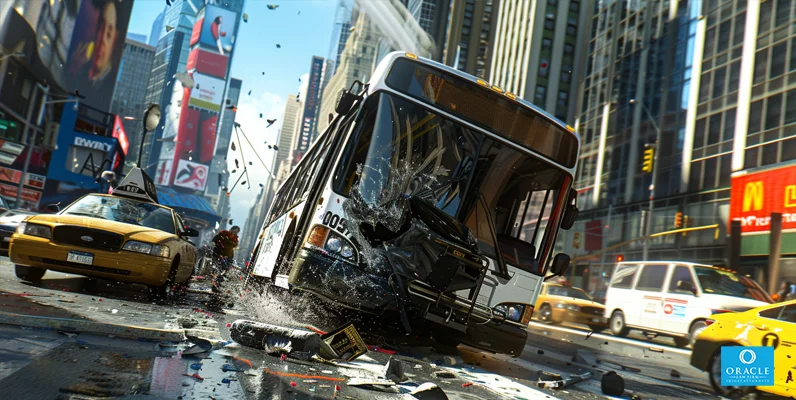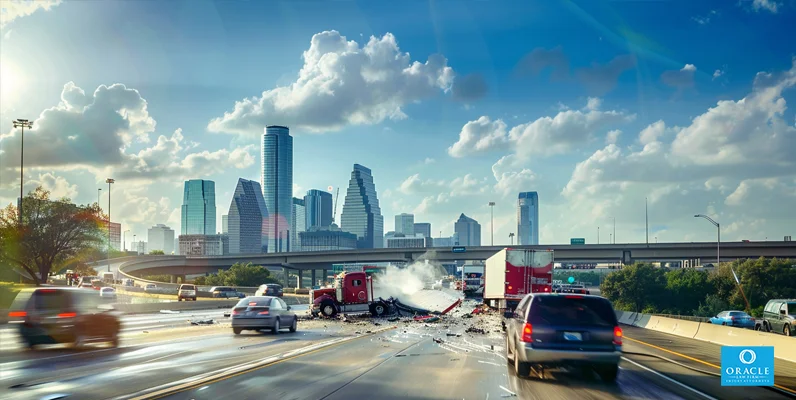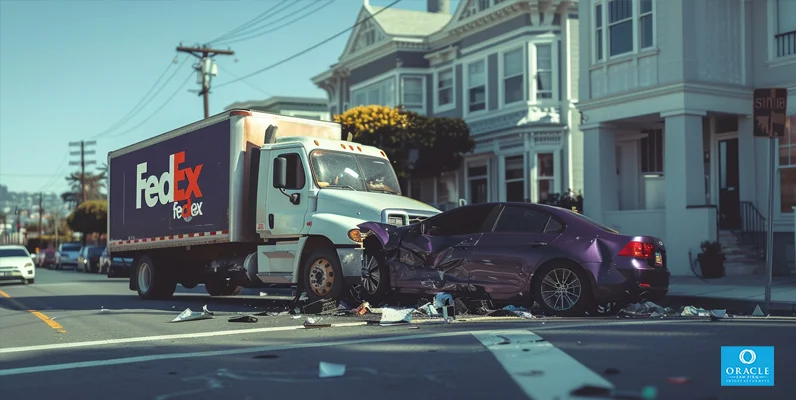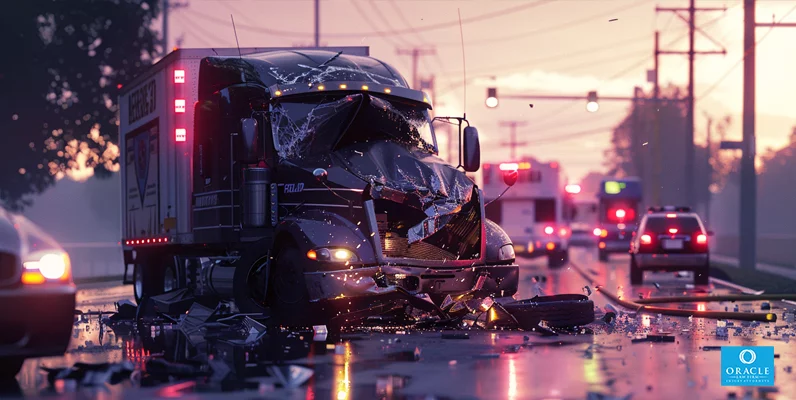Where do most crashes happen? The answer might be closer than you think. Research indicates that most vehicular accidents occur within a 25-mile radius of the driver’s residence. Our comprehensive guide pinpoints and explains why certain locations like residential areas, rural roads, and parking lots are accident hotspots without inundating you with statistical jargon. We’re tackling the crucial details so you’re better equipped to navigate these common yet overlooked dangerous areas.
Key Takeaways
- Most vehicle collisions occur near home, on rural roads, or in parking lots due to overconfidence, complacency, high-speed limits, inadequate lighting, and design issues.
- Traffic accidents are more likely during peak travel times, such as rush hours and weekends, and can be influenced by seasonal conditions that affect road safety, particularly in the summer.
- Driver behavior, including distracted driving and aggressive maneuvers such as speeding, is recognized as the primary cause of road traffic accidents, emphasizing the need for defensive driving and adherence to traffic laws.
Exploring the Hotspots for Vehicle Collisions
Much as in real estate, the location of a car crash or accidents matters greatly. Certain areas, or “hotspots”, are more prone to collisions due to various factors. We will now investigate three prominent vehicle collision hotspots: close to home, on rural roads, and within parking lots.
The Home Zone Hazard
Many mistakenly believe long, perilous road trips or hectic city traffic represent the most probable car accident scenarios. However, statistics reveal a different story. Most car accidents happen close to accident victim’s home too, as most automobile accidents resulting in severe injury or fatal car accidents occur within a 25-mile radius of one’s home. What could be the reason for this?
When we drive on familiar routes, such as those near our homes, we may become complacent and engage in riskier behavior. Overconfidence and familiarity often lead to distraction, increased traffic violations, and exceeding speed limits. Additionally, the design of residential areas can contribute to the risk of vehicle collisions. Poor road design, reduced visibility due to taller vehicles, and inadequate safe walking infrastructure are all factors that can increase the likelihood of collisions near home.
Perils on Rural Roads
Congested urban streets in urban areas usually come to mind when envisaging hazardous driving conditions. However, rural roads pose their own perils and are the site of approximately 46% of fatal accidents. What precisely renders both rural and urban areas’ roads this dangerous?
Several factors contribute to the high rate of accidents on rural roads. Higher speed limits, less police presence, and inadequate lighting are all significant contributors. Rural roads often have higher speed limits due to lower traffic volumes, fewer pedestrians, and road geometry that allows for higher speeds. However, higher speeds can also lead to more severe accidents, including fatal ones.
Additionally, the reduced police presence on rural roads can result in drivers exceeding speed limits thus increasing the likelihood of nonfatal accidents. Lastly, inadequate lighting on rural roads can significantly hinder drivers’ ability to navigate safely, especially during nighttime.
Chaos in Parking Lots
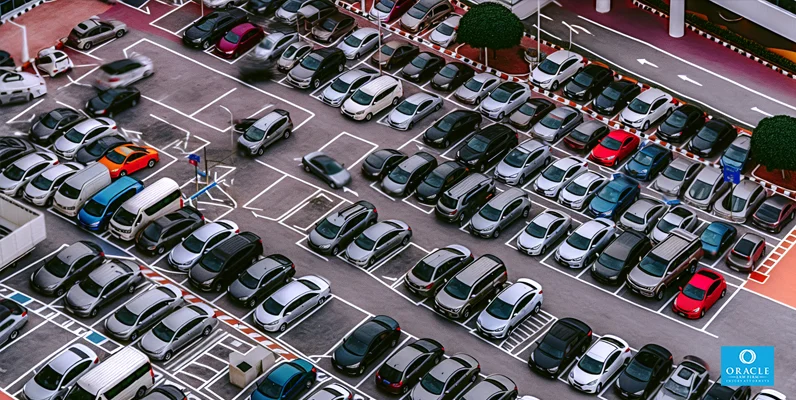
Parking lots may appear as safe havens compared to busy highways or rural roads. However, they present their own unique set of challenges. Parking lots are considered high-risk areas for vehicle collisions.
The primary factors contributing to parking lot accidents include distractions, poor lighting, sharp corners, and poor pavement conditions. The design of a parking lot can also contribute to accidents. Cramped spaces, confusing traffic flow, faded lane markings, potholes, and poor lighting can all increase the likelihood of accidents.
Frequent vehicle maneuvering, such as reversing, and the presence of pedestrians add to the risk of collisions. So, next time you’re circling the lot for the perfect spot, remember to stay alert and drive cautiously.
Timing and Conditions: When and How Accidents Occur
Certain times and conditions, like specific locations, are more prone to accidents. From rush hour traffic to weekend getaways, travel timing can greatly impact the likelihood of an accident. Additionally, seasonal changes can affect road conditions and visibility, leading to increased accidents. As we all know, car accidents happen, so awareness of these factors can help reduce the risk of car accidents. It’s important to remember that fatal accidents happen, too, making it crucial to stay vigilant and cautious on the road. However, nonfatal accidents happen can also happen, and they can still cause significant damage and injuries.
These factors warrant a more detailed examination.
Peak Times for Traffic Mishaps
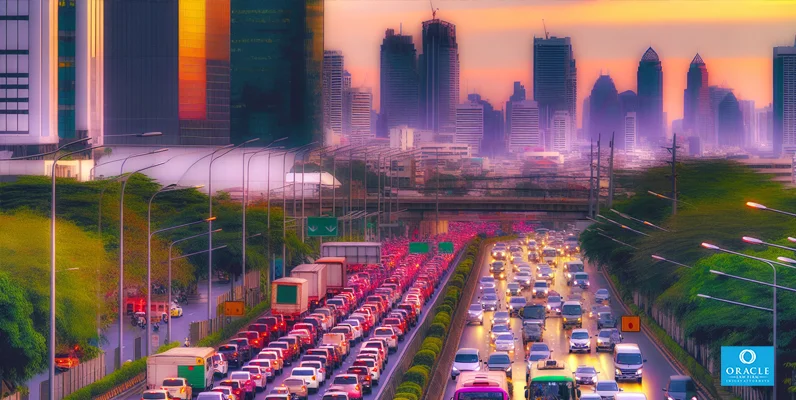
If you’ve ever been stuck in rush hour traffic, you know that the roads can become a jungle of jostling cars all vying for space. This increased road congestion during the morning and evening commute times significantly elevates the risk of collisions.
But it’s not just weekdays we have to worry about. Surprisingly, weekends, especially Saturdays, see a higher incidence of fatal car crashes, with some of the most fatal car accidents occurring during this time. This is often due to increased leisure activities such as recreational sports, which lead to more traffic and potential inattention or impaired driving. Furthermore, the peak time of day for most fatal accidents and nonfatal crashes is from 4 p.m. to 7:59 p.m., with nonfatal crashes tending to be higher on weekdays and fatal crashes more frequent on weekends.
Seasonal Surge in Accidents
Changing seasons bring about varying road conditions. These changing conditions can significantly impact the frequency and severity of road accidents. For example, there is a notable increase in traffic accidents during the summer months.
This surge in accidents can be attributed to a variety of factors, including:
- More travel during the summer months due to vacations, resulting in more vehicles on the road
- Increased social gatherings and events, which can lead to an increase in impaired driving
- Increased sunlight during the summer months which can cause glare and impair drivers’ vision
Understanding Accident Dynamics
Accidents are not all created equal. The dynamics of a collision can greatly impact the severity and outcome of an accident. We will next scrutinize two types of accident dynamics: interactions at intersections and single vs. multi-vehicle crashes.
Intersection Interactions
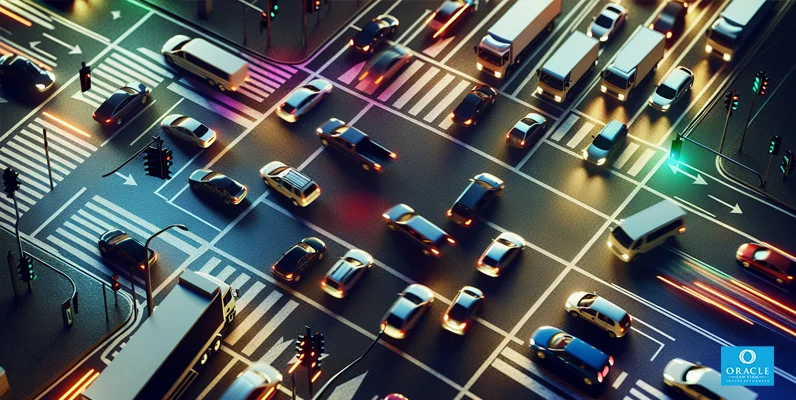
Intersections are a common site for accidents. With multiple pathways for vehicles and the potential for confusion among drivers, intersections pose a significant risk for collisions. What specifically causes intersections to be so perilous?
Firstly, intersections involve multiple pathways for vehicles, which can lead to confusion among drivers. Secondly, intersections often have stop signs and involve numerous traffic signals and signs, which drivers must interpret correctly to navigate safely. These factors can lead to a high incidence of collisions, with various accident types such as rear-end collisions, angle accidents, sideswipe accidents, and head-on collisions commonly occurring at intersections.
Single Vehicle vs. Multi-Vehicle Crashes
When we think of car accidents, we often picture multiple vehicles colliding. However, single-vehicle crashes account for over 60% of car accident fatalities each year. What makes single-vehicle crashes distinct from multi-vehicle ones?
Single-vehicle crashes, also known as motor vehicle accidents, commonly involve vehicles veering off the road or colliding with objects. This type of accident or crash is particularly common in rural areas, where factors such as running off the road, collisions with trees or utility poles, and adverse weather conditions can lead to single-vehicle crashes.
On the other hand, multi-vehicle crashes, which involve multiple vehicles colliding with each other, are more common in urban settings and at intersections. These crashes often result from incorrect judgments, erratic driving, disobeying traffic signals, and heavy traffic congestion from other vehicles. It’s important to remember that car crashes happen, and awareness of these factors can help prevent them.
The Role of Driver Behavior in Accidents
While external factors such as location, timing, and accident dynamics play a significant role in causing accidents, driver behavior is also crucial. Human behavior is widely recognized as the primary cause of road traffic accidents.
Next, let’s analyze two dangerous driving behaviors: distraction and aggressive maneuvers.
Distracted Driving Dilemmas
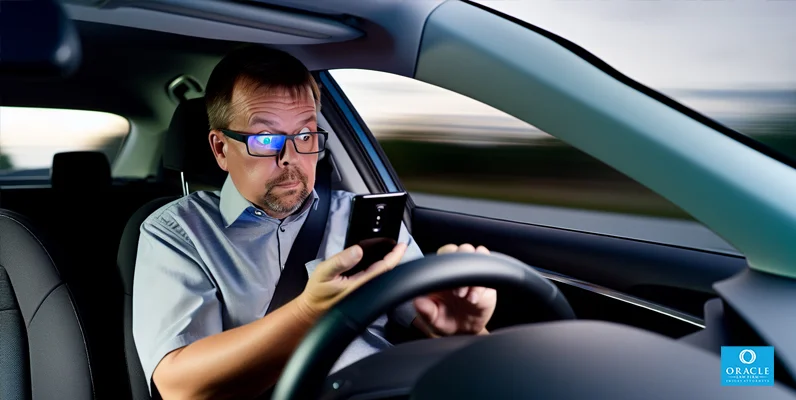
We live in a world of constant distractions. From text messages to food, countless things are vying for our attention – even while driving. This distracted driving significantly raises the risk of motor vehicle crashes.
Distracted driving can take many forms. Manual distractions such as eating, drinking, and smoking are common. However, distractions involving electronic devices, such as talking or texting on the phone, are particularly dangerous. Using a phone while driving can lead to reduced focus on the road, one-handed steering, and longer reaction times. Even seemingly harmless activities such as eating can significantly raise the likelihood of being involved in a car accident.
Aggressive Maneuvers and Speeding
While distracted driving is a significant concern, aggressive driving and speeding are just as dangerous. In fact, over 50% of all traffic fatalities are attributed to aggressive driving. What characterizes aggressive driving, and what makes it exceedingly dangerous?
Aggressive driving can involve a variety of behaviors, including:
- Speeding
- Tailgating
- Improper lane changes
- Running red lights
Speeding, in particular, contributes to a higher number of traffic fatalities and increases the likelihood of severe injuries, even when driving at the speed limit. Aggressive driving can also compromise cognitive abilities, reducing driver reaction time.
Legal Aftermath: What Comes Next?
Experiencing a car accident can be highly traumatic. In the aftermath of a collision, taking immediate action and seeking legal advice is crucial to ensure proper compensation and resolution.
We’ll now examine the immediate steps after an accident and discuss the importance of seeking legal advice.
Immediate Actions Post-Accident
The moments following a car accident can be chaotic and disorienting. However, remaining calm and following a few critical steps is important. These include:
- Checking for injuries
- Moving to a safe location, if possible
- Contacting emergency services
- Waiting for assistance
Another crucial step is to exchange information with the other drivers involved in the accident. This includes providing your full name and contact information, insurance company and policy number, driver’s license and license plate number, and the vehicle’s type, color, and model. Additionally, gathering as much evidence as possible from the accident scene is important. This includes taking photographs, obtaining statements from witnesses, and collecting details from the driver’s license, owner’s card, and insurance card.
Seeking Legal Advice
After an accident, you may face medical bills, property damage, lost wages, and other expenses. It’s in these situations that seeking legal advice can be extremely beneficial. Consulting with an attorney can clarify your rights, assist in the medical expenses, navigating the claims process, and ensure equitable compensation.
The financial implications of hiring a lawyer can vary. However, the benefits often outweigh the costs. A lawyer can:
- Protect against legal claims
- Review entitlement to damages
- Guide evidence collection
- Assess accident-related expenses
- Manage negotiations with insurers
- Provide courtroom experience
So, in the aftermath of an accident, don’t hesitate to seek the professional advice of a car accident lawyer.
Preventive Measures to Reduce Road Risks
It’s as vital to know how to prevent accidents as it is to understand where, when, and why they occur. Implementing preventive measures, such as defensive driving habits and strict adherence to traffic laws, can significantly reduce the risk of accidents.
Let’s examine these preventive measures more closely.
Defensive Driving Habits
Driving is not just about operating a vehicle. It’s also about being aware of your surroundings and anticipating potential hazards. This is the essence of defensive driving. What does the concept of defensive driving encompass? Defensive driving encompasses a variety of habits and strategies, including:
- Aiming high
- Avoiding distractions
- Driving sober
- Checking vehicle safety
- Following traffic laws
- Anticipation and planning
Anticipation and awareness can diminish the risk of vehicle collisions by enabling drivers to proactively respond to perilous circumstances and enhance their ability to anticipate hazards.
Maintaining a safe speed is also critical in contributing to defensive driving as it reduces the risk of accidents and minimizes the impact of driver mistakes.
Adherence to Traffic Laws
Many view traffic laws as mere suggestions or nuisances. However, these laws are in place to ensure the safety of all road users. Strictly adhering to traffic laws can significantly decrease the likelihood of accidents.
Adhering to traffic laws includes following speed limits, obeying traffic signals, and respecting right-of-way rules. Following speed limits enables safer stopping distances for motorists, accident prevention, and reduced injury severity. Obeying traffic signals mitigates hazardous interactions with oncoming traffic and lowers the risk of multi-vehicle pileups.
So, the next time you’re tempted to speed through a yellow light or roll through a stop sign, remember that these laws are there to keep us all safe.
Summary
Understanding the various factors that contribute to car accidents can help us take steps to prevent them. Whether it’s becoming more aware of accident hotspots, being mindful of peak accident times, understanding different accident dynamics, or recognizing our behavior’s role in accidents, every bit of knowledge empowers us to become safer drivers. We can ensure proper compensation and resolution by taking immediate action after an accident and seeking legal advice. And most importantly, by adopting defensive driving habits and adhering strictly to traffic laws, we can significantly reduce the risk of accidents. Remember, safety in motor vehicles is no accident – it’s a choice.
Frequently Asked Questions
Where is the most common place for crashes?
The most common place for car crashes is near the victim’s home, including in neighborhoods and on rural roads. Intersection and parking lot crashes are also frequent. It’s important always to use seatbelts, regardless of the destination.
Why are most accidents close to home?
Most accidents happen close to home due to overconfidence, distraction, risky behavior, poor road design, and inadequate safe walking infrastructure. It’s important to remain vigilant, even in familiar surroundings.
What are the peak times for traffic accidents?
The peak times for traffic accidents are during rush hour (morning and evening) and on weekends, especially Saturdays. Be extra cautious during these times.
What is the role of driver behavior in accidents?
Driver behavior, such as distracted driving and aggressive maneuvers, significantly contributes to causing accidents on the road. Human behavior is widely acknowledged as the primary cause of traffic accidents.
What are some preventive measures to reduce road risks?
It is important to adopt defensive and safe driving habits such as anticipation and planning to reduce road risks and strictly adhere to traffic laws.


